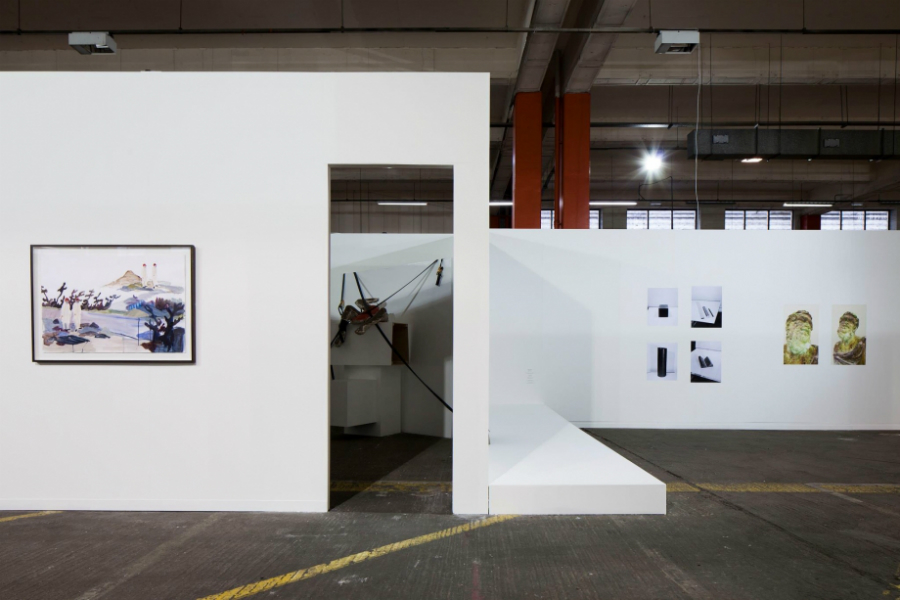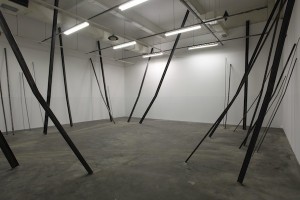What’s left behind: LJMU Copperas Hill

In the final weekend of Biennial 2012, C James Fagan muses on the relative success – or otherwise – of the work at Copperas Hill…
One thing we’ve come to expect from the Liverpool Biennial is that it will find unique places outside of ‘white cube’ galleries in order to make itself at home. The last two Biennials have been prime examples of that, think 2010’s use of the old Rapid Hardware store, and this year’s Biennial which has used the grandeur of the Cunard buildings and the less grand but no less impressive space of a former mail sorting factory, recently acquired by John Moores University, tucked behind Lime St Station on Copperas Hill.
I’m not sure how to describe it, it’s big. I remember my reaction on my first visit there, which was a desire to run around, to re-enact pivotal scenes from Star Wars. I haven’t begun to pay attention to the art work yet. I find the space distracting, looking around at what’s left behind by years of postal industry (including post-it-notes and notices stuck up with old, fraying sellotape). Why on one column has someone pasted a large number of stamps? My head becomes filled with the imagined thunder of the movement of machines and people, the sinew and power of pre-digital communication.
Like the other large-scale exhibition space at The Cunard, the place which houses the art threatens to overpower it. Especially the work in the Bloomberg New Contemporaries (main picture), which seems to cling to the white stud wall built to house it. Of course it would be wrong to expect work by an artist at this level to confidently fill a space like Copperas Hill; after all, these are recent graduates. During my own student life I never made anything that would fit within this space. That aside, my overall impression of the New Contemporaries is one of fracture.
I can’t say whether this is because there’s a sense of the artist responding to an increasing fracturing world. If the artists are attempting to come to terms with a world of so much sensory input, they are adding to this input, pushing this world of fracture into something, to create new and relevant meanings.
Walking around, I see work that I can only refer to as ‘splodgey’, or that have many layers piled on top of them – it’s difficult to see what the intent is. An example is Salome Ghazanfari’s The Boxer (Young Marble Giants), where a monitor on a trolley plays a video of boxers backed by hurried black brushstrokes. It faces a pile of white wooden boxes with some kind of figure strapped on (with the straps you see on the side of trucks). I don’t know if this is a comment or critique on male masculinity or some very oblique reference to the New Wave scene.

Whatever the meanings, I felt it hard to engage with some of the works, getting lost within possible layers of meaning. I would like to say there were works which I engaged with – the pugilist figure of Anita Delany was great, but on subsequent visits this piece wasn’t working. I understand, however, that these are the works of artists at the initial stage of their careers. Isn’t that part of the remit of the New Contemporaries, to earmark the artists currently out there with the potential to grow?
New Contemporaries shares the Copperas Hill building with City States. It’s the type of exhibition Biennials are famous for, that being a large selection of works from around the world, and when you think about it, these things give you plenty of bang for your buck (especially as we don’t pay to see it).
Cities from Hong Kong to Birmingham are represented and you are free to roam between them. Which means you can find yourself wandering from Gdansk to Copenhagen to Korea without realising it. This led to me considering slight contradictions of how similar and yet different the art was. I wonder if this was a result of a more interconnected world, or was it simply due to a sharing of influences? It’s something which a Biennial show can bring to the forefront of your thinking. Though it was clear to see the artists’ or countries’ individual concerns, which often provide some surprises (such as a sense of ‘guilt’ present in the work at the Copenhagen pavilion; the almost shamanistic world of the North Atlantic Pavilion; the introspection of Gdansk).
Some odd things happen such as Andrius Bucas & Valdas Ozanirnskas Black Pillow, a huge inflated structure, which sits comfortably with the space and therefore defeats the concepts behind the piece. Or Chiu Chen-Hung’s floating ramshackle apparition with bird song voices, that hovers like an unexpected and reluctant guest in the Taipei area. Or caught in the voyeuristic maze of Leung Mee-ping’s Out of Place, watching the gentle OAPs move gingerly through the streets of their home city. This in particular highlighted the fact that even within our ‘homes’ we can discover ourselves unexpected and unwelcome guests.
There are occasions where all this work fits into the Biennial’s general theme of Hospitality. Is it a sense of artist and viewer meeting on common ground, both groups in a sense welcoming each other into a shared experience? Though I don’t expect a slavish adherence to the themes, it makes reading some of the work difficult as you attempt to put it through this filter of ‘hospitality.’ Often I found myself feeling that some element was missing that would aid my understanding of the work I was seeing. This led to a misreading of the Jorge Macchi piece (pictured) on my first experience of this installation, comprised of steel girders resting against the walls. I initially thought that it was a comment on how the institutions that surrounds us are all precariously balanced and can fall at any moment. I was wrong – it was an attempt to recreate the effect of the light being refracted through water.
But for what faults the exhibition may have they are outweighed by the fact of its existence. For the last ten weeks the citizens of Liverpool and beyond have had access to what may be one of the largest exhibitions of its type in the country. We have been able to enter into a dialogue (I know it’s a bit of corny art-speak) with art and artists and therefore, I hope, come to an understanding about the type of art we value and why.
C James Fagan
Biennial 2012 10am – 5pm in venues across the city until Sunday 25th November





